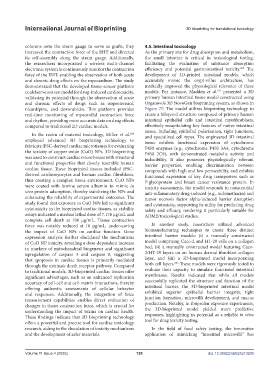Page 128 - v11i4
P. 128
International Journal of Bioprinting 3D bioprinting for translational toxicology
columns onto the strain gauge to serve as grafts, they 4.5. Intestinal toxicology
increased the contraction force of the EHT and directed As the primary site for drug absorption and metabolism,
its self-assembly along the strain gauge. Additionally, the small intestine is critical in toxicological testing,
the researchers incorporated a wireless multi-channel facilitating the evaluation of substance absorption
electronic system to continuously monitor the contraction efficiency and potential gastrointestinal toxicity. The
208
force of the EHT, enabling the observation of both acute development of 3D-printed intestinal models, which
and chronic drug effects on the myocardium. The study accurately mimic the crypt-villus architecture, has
demonstrated that the developed tissue-sensor platform markedly improved the physiological relevance of these
192
could serve as a test model for drug-induced cardiotoxicity, models. For instance, Madden et al. presented a 3D
validating its potential through the observation of acute primary human intestinal tissue model constructed using
and chronic effects of drugs such as isoproterenol, Organovo’s 3D NovoGen bioprinting system, as shown in
nicardipine, and doxorubicin. This platform provides Figure 7F. The model utilizes bioprinting technology to
real-time monitoring of myocardial contraction force create a bilayered structure composed of primary human
and rhythm, providing more accurate data on drug effects intestinal epithelial cells and intestinal myofibroblasts,
compared to traditional 2D cardiac models. effectively recapitulating key features of native intestinal
tissue, including epithelial polarization, tight junctions,
In the realm of material toxicology, Miller et al. and specialized cell types. The engineered 3D intestinal
204
employed advanced 3D bioprinting technology to tissue exhibits functional expression of cytochrome
fabricate iPSC-derived cardiac microtissues for evaluating P450 enzymes (e.g., cytochrome P450 3A4, cytochrome
the toxicity of copper oxide (CuO) NPs. 3D bioprinting P450 2C9), with demonstrated metabolic activity and
was used to construct cardiac microtissues with structural inducibility. It also possesses physiologically relevant
and functional properties that closely resemble human barrier properties, enabling discrimination between
cardiac tissue. These bioprinted tissues included iPSC- compounds with high and low permeability, and exhibits
derived cardiomyocytes and human cardiac fibroblasts, functional expression of key drug transporters such as
thus creating a complex tissue environment. CuO NPs P-glycoprotein and breast cancer resistance protein. In
were coated with bovine serum albumin to mimic in toxicity assessments, the model responds to nonsteroidal
vivo protein adsorption, thereby stabilizing the NPs and anti-inflammatory drug-induced (e.g., indomethacin) and
enhancing the reliability of experimental outcomes. The tumor necrosis factor alpha-induced barrier disruption
study found that exposure to CuO NPs led to significant and cytotoxicity, supporting its utility for predicting drug
cytotoxicity in the bioprinted cardiac tissues, as viability safety and efficacy, rendering it particularly suitable for
assays indicated a median lethal dose of 7.176 μg/mL and ADME/toxicological studies.
complete cell death at 100 μg/mL. Tissue contraction
force was notably reduced at 10 μg/mL, underscoring In another study, researchers utilized advanced
the impact of CuO NPs on cardiac function. Gene biomanufacturing techniques to create three distinct
expression analysis further elucidated the mechanisms intestinal barrier models: (i) a manually constructed
of CuO NP toxicity, revealing a dose-dependent increase model comprising Caco-2 and HT-29 cells on a collagen
in markers of mitochondrial biogenesis and significant bed, (ii) a manually constructed model featuring Caco-
upregulation of caspase 3 and caspase 8, suggesting 2/HT-29 layers on an human dermal fibroblast collagen
that apoptosis in cardiac tissues is primarily mediated layer, and (iii) a 3D-bioprinted model incorporating
206
through the extrinsic death receptor pathway. Compared both cell layers. These models were rigorously tested to
to traditional models, 3D-bioprinted cardiac tissues offer evaluate their capacity to simulate functional intestinal
significant advantages, such as an enhanced replication membranes. Results indicated that while all models
accuracy of cell-cell and cell-matrix interactions, thereby successfully replicated the structure and function of the
offering authentic assessments of cellular behavior intestinal barrier, the 3D-bioprinted intestinal model
and responses. Additionally, the integration of force exhibited superior epithelial barrier integrity, tight
measurement capabilities enables direct evaluation of junction formation, microvilli development, and mucus
changes in tissue contraction force, which is crucial for production. Notably, in ibuprofen exposure experiments,
understanding the impact of toxins on cardiac health. the 3D-bioprinted model yielded more predictive
These findings indicate that 3D bioprinting technology responses, highlighting its potential as a reliable in vitro
offers a powerful and precise tool for cardiac toxicology tool for drug toxicity testing.
research, aiding in the elucidation of toxicity mechanisms In the field of food safety testing, the innovative
and the development of safer materials. application of mimicking “intestinal microvilli” has
Volume 11 Issue 4 (2025) 120 doi: 10.36922/IJB025210209

